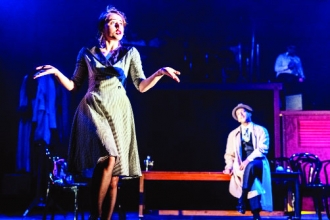Director-actor Atul Kumar’s play Detective Nau-Do-Gyaraah is a mix of affectionate longing for the past and laughter.
Theatre is a game of spotlights. Just as the reader follows the lead through reading, the audience follows the lead through a spotlight on a stage. It is a background of imagination, sets the context for the dialogues and brings the characters alive. This effect was used justifiably to bring together drastically different worlds of graphic novels and gangster films and recreate the effect of swinging between cynicism and certainty in Atul Kumar’s play Detective Nau-Do-Gyaraah, an adaptation of Alfred Hitchcock’s 39 Steps and a tribute to film noir.
Set in the 1940s and 50s Mumbai, it depicts an interplay of murder, romance, mystery, deceit as well as comedy. However, combining comedy and serious issues like crime and murder definitely makes it a play quite different from a classic murder mystery. Says Atul, “Some of the masters of suspense in cinema freely use comedy as relief to enhance the intrigue and mystery in their stories. Hitchcock is its best example. Our work has always been about turning everything on its head, so we never did mystery in its conventional form. The aim was to adapt and make it theatrical and fun.”
The play transcends the mystical journey of psychiatrist Shekhar Kumar, who travels from Khandala to Mumbai for an evening at the iconic Royal Opera House, and finds himself entangled in gunshots and trapped with the Bombay mafia with a damsel in distress. Shekhar has heroic ambitions thrust upon him when he finds that he is the country’s last hope. In the process, he discovers an international spy ring and falls in love.
A live jazz band performing in the background creates a dramatic effect and paces the action. Atul explains, “I always saw the score for jazz and swing tunes as they used to be in Hindi cinema in the 1940s and 50s. We selected a few freelancers and made a band specially for this play and composed some original tunes for the show. Though I am still working on them, the show wouldn’t have had half an impact without them.”
The play jumps from genre to genre, setting up and creating a period atmosphere. Atul reveals how he derived inspiration and tried to borrow culture from comics, series, even Indian films and serials like CID. “The images are influenced from cinema, photos and comics that one has grown up with. It’s only the impressions as none of us really had lived in that era. To me, it sometimes feels like fiction.”
The play has hardly faltered on the screenplay and Atul has wisely relied on a Hitchcockian template. The director says it is always important to be truthful. “It is a constant struggle because often one has to compromise to create an effect or reach a target through means that are surfaced and not grounded in any depth. The fight is always on.”
The play, as he tells us, is not entirely an adaptation of Hitchcock’s 39 Steps but has scenes from a few of his films. However, it has been inspired from the original novel by Buchan and importantly from many Hindi films of the 1950s where the villain is a fugitive and planning mass destruction. Spies, cops and gangsters abound. In fact, the title Nau-do-gyaarah (9-2-11, a Hindi idiom for disappearing) is inspired from Hitchcock’s The Lady Vanishes again. “It (9-2-11) has a quality of running, vanishing, as well as fast pace. It is a catchy and cheesy title just like the genre,” the director tells us.
Atul’s challenge was to make the dialogues communicable to the contemporary generation. “The way actors in old Hindi films spoke is still etched in everyone’s memories. So when you do a parody, it already is on a funny ground and the audience is with you. The rest of the work was done by the writers, Gagan Dev Riar, Niketan Sharma and Pallav Singh. The references were the cinematic images of that era and we simply recreated them.”
The protagonist himself is representative of anxieties and self-doubts of the current era. Explaining his rationale, Atul says, “He could easily take a pathway which is legal but he choose to resolve the mystery by himself. He constantly makes decisions in his journey that are unconventional. One wonders if they are really good for the nation or for his own ego and identity. Does he really care for his country or for himself?” Yet this self-questioning is done with a positive energy. As Atul is currently gearing up for curating theatre for the Serendipity Arts Festival in Goa in December, he draws his inspiration from “the young people who question everything of the past and are always ready to explore their roots.”
Writer: Chahak Mittal
Courtesy: The Pioneer








 OpinionExpress.In
OpinionExpress.In















Comments (0)